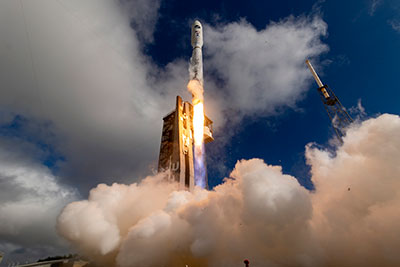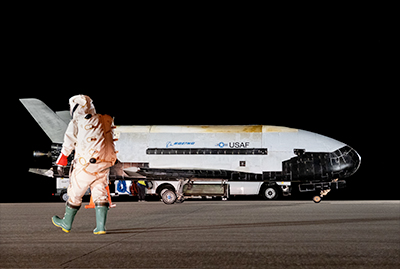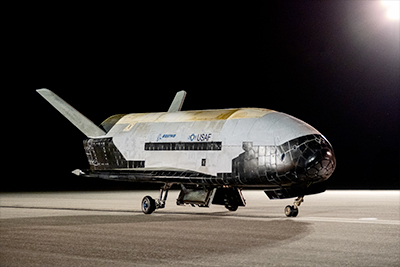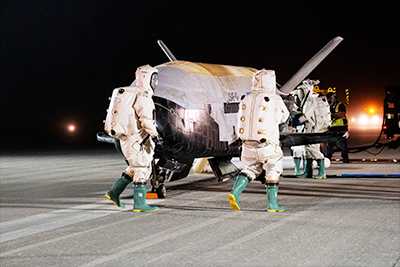|
|

|
 |
| Forum: | Commercial Space - Military Space |
| Topic: | ULA Atlas V/OTV-6 (X-37B) from LC-41 |
|
| Want to register?
|
If you have previously registered, but forgotten your password, click here.
| | Robert Pearlman | United Launch Alliance (ULA) release United Launch Alliance Successfully Launches the Sixth Orbital Test Vehicle for the U.S. Space ForceA United Launch Alliance (ULA) Atlas V 501 rocket carrying the USSF-7 mission for the U.S. Space Force lifted off on May 17, 9:14 a.m. EDT, from Space Launch Complex-41. This marks the 84th successful launch of an Atlas V rocket, 139th launch for ULA, the second launch for the U.S. Space Force and the sixth flight of the X-37B Orbital Test Vehicle (OTV-6).  "The success of this mission resulted from collaboration with our customer while working through challenging, and ever changing, health and safety conditions," said Gary Wentz, ULA vice president of Government and Commercial Programs. "We were honored to partner with the U.S. Space Force to dedicate this mission to first responders, front-line workers, and those affected by COVID-19. It is truly a unique time in our history and I want to thank the entire team for their continued dedication and focus on mission success." Along with OTV-6, this mission deployed FalconSat-8, a small satellite developed by the U.S. Air Force Academy and sponsored by the Air Force Research Laboratory (AFRL) to conduct experiments on orbit. The mission also carried two NASA experiments, including a material sample plate to determine the results of radiation and other space effects on various materials, and an experiment which will assess space effects on seeds used to grow food. Another experiment sponsored by the Naval Research Laboratory will examine the ability to transform solar power into radio frequency microwave energy which could be transmitted to the ground. This mission launched aboard an Atlas V 501 configuration rocket that included a 5-meter-diameter payload fairing. The Atlas booster was powered by the RD AMROSS RD-180 engine, and the Centaur upper stage was powered by the Aerojet Rocketdyne RL10C-1 engine. | | Robert Pearlman | U.S. Space Force release X-37B orbital test vehicle concludes sixth successful missionThe X-37B Orbital Test Vehicle-6 (OTV-6), the U.S. Space Force's unmanned, reusable spaceplane, successfully deorbited and landed at NASA's Kennedy Space Center Shuttle Landing Facility on Nov. 12, 2022, at 05:22 a.m. EST.  Above: X-37B orbital test vehicle concludes sixth successful mission. (Staff Sgt. Adam Shanks/USSF) OTV-6 was the first mission to introduce a service module — a ring attached to the rear of the vehicle expanding the number of experiments that can be hosted during a mission. "This mission highlights the Space Force's focus on collaboration in space exploration and expanding low-cost access to space for our partners, within and outside of the Department of the Air Force (DAF)," said Gen. Chance Saltzman, Chief of Space Operations. The service module successfully separated from the OTV before landing, which is a necessary activity due to the aerodynamic forces experienced by the X-37B vehicle upon re-entry. In the coming weeks, the service module will be disposed of in accordance with best practices. Secretary of the Air Force Frank Kendall said, "The deliberate manner in which we conduct onorbit operations-to include the service module disposal-speaks to the United States' commitment to safe and responsible space practices, particularly as the issue of growing orbital debris threatens to impact global space operations."  The OTV-6 mission hosted the Naval Research Laboratory's Photovoltaic Radiofrequency Antenna Module. This experiment successfully harnessed solar rays outside of Earth's atmosphere and aimed to transmit power to the ground in the form of radio frequency microwave energy. Additionally, the U.S. Air Force Academy's FalconSat-8, developed in partnership with Air Force Research Laboratory, was successfully deployed in October 2021. FalconSat-8 remains in orbit, providing Academy cadets unique hands-on experience as space operators prior to entering active duty. Multiple NASA experiments were deployed on OTV-6. The Materials Exposure and Technology Innovation in Space (METIS-2) included thermal control coatings, printed electronic materials, and candidate radiation shielding materials. METIS-1-which flew on OTV-5-consisted of similar sample plates mounted on the flight vehicle. NASA scientists will leverage data collected after the materials have spent 900+ days in orbit and compare observed effects to ground simulations, validating and improving the precision of space environment models. Another NASA experiment aims to investigate the effect of long-duration space exposure on seeds. Scientists are interested in the seeds' resistance and susceptibility to space environment-unique stresses, notably radiation. The seeds experiment will inform space crop production for future interplanetary missions and the establishment of permanently inhabited bases in space.  "The X-37B continues to push the boundaries of experimentation, enabled by an elite government and industry team behind the scenes," said Lt. Col. Joseph Fritschen, DAF Rapid Capabilities Office's X-37B Program Director. "The ability to conduct on-orbit experiments and bring them home safely for in-depth analysis on the ground has proven valuable for the Department of the Air Force and scientific community. The addition of the service module on OTV-6 allowed us to host more experiments than ever before." The sixth mission conducted on-orbit experiments for 908 days. | |





